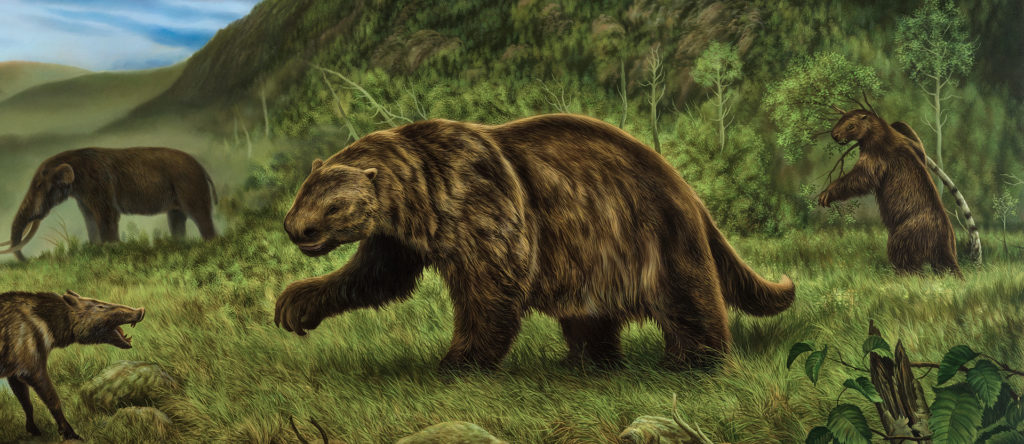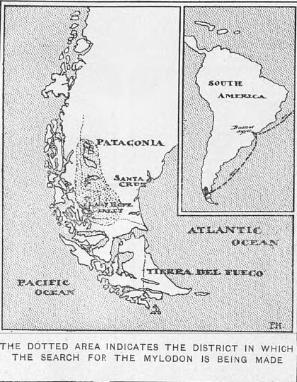Mysterious Sloth Monster in Patagonia April 18, 2018
Author: Beach Combing | in : Modern , trackbackThe Giant Sloth?
The giant ground sloth is one of the most charismatic of extinct creatures. Dwelling in South America Megatherium was, when it tore down trees, and walked over the pampa, the size of a small elephant and was finally hunted out of existence about 10,000 years ago: one of the victims of homo sapiens’ remorseless expansion. However, in the late nineteenth century rumours began to appear that the giant sloth had survived in a secret corner of Patagonia. Here is the first glimmers of interest in a search in a British newspaper dated 7 Jan 1899 (Croy Guard)
Considerable interest attaches to the expedition to Southern Patagonia on which Mr. H. S. H. Cavendish and Mr. Edward Dodson have just started…. A short time back zoologists were roused to unwonted excitement by a report, apparently well authenticated, concerning a mysterious quadruped said to exist in the interior of the territory of Santa Cruz, living in burrows hollowed out in the soil, and coming out only at night. According to the reports of the natives, it was a strange creature with long claws and a terrifying appearance, and impossible to kill because it had a body impenetrable alike to firearms and missiles. These reports were not treated as idle tales, because several years back the late Ramon Lista, a traveller well known in the scientific world, had stated that he had come across a mysterious quadruped during one of his journeys in the interior of Southern Patagonia, but in spite of all his efforts he was unable to capture it, several shots failing to stop the animal, which disappeared in the brushwood. Recently further evidence of a more tangible kind has come to hand from Signor Ameglimo, a noted naturalist in Buenos Ayres, who has obtained possession of a skin, unfortunately incomplete, which he believes, with good scientific reasons, to have belonged to a specimen of the mysterious creature seen by Lista. He thinks the animal to be the last representative of a group, which was considered to be quite extinct, of Gravigrade edentata, related to the Giant Ground Sloth or megatherium.
This is the crucial meeting of two streams of evidence that led to the excitement. First, Lista saw a mysterious animal, which he, though, would later claim, was too small to be a giant sloth. Second a sloth skin came onto the market, after one was discovered in a Patagonian cave in 1895. A third stream of information seems to have been gifted by local Indians.
Professor Ameglimo’s narrative prompted further inquiries from scientific quarters here, which elicited almost certain proofs of the existence of the animal, and quite recently there has, I am told, been received here a confidential communication on the subject of this mammal, giving some surprising intelligence, obtained from the Indians, as to its distribution, character and habits. Mr. Cavendish, who had been obliged to abandon his projected journey in British East Africa, was sounded as to his willingness to go in search of the stranger and very generously decided to organise as expedition for the purpose, taking with him Mr. Dodson as naturalist. The two travellers have been placed in possession of all the information, and the authorities of the Natural History Museum have given them directions as to the probable whereabouts of the beast. The hunt for it could not be delayed, since two scientific foreign expeditions have already gone to Southern Patagonia; but as Mr. Cavendish is, I understand, the only person who has full knowledge of the circumstances, we may hope to see at South Kensington [i.e. in the museum] ere long a specimen of this last representative of a group which of old played a preponderating part in the terrestrial fauna of Southern America.
What was it?
A series of Megatherium remains were later found in Patagonian caves, including skins with flesh on them, that had presumably been preserved by the extreme cold: recent carbon dating has shown that, despite their fresh appearance, they were over ten thousand years old. The Megatherium had not walked the earth in Patagonia for generations, then: this remains the opinion of most zoologists. However, what remains interesting are the descriptions of the local monster that so terrified the Indians. Here is a report from the British press at the end of the year. The Indians called the creature the ‘Iemisch,’ ‘the water tiger’.
The Tehuelche Indians among whom [Ameglimo] lived furnished him with some precise notes on the ‘Iemisch’, shewing that it was not a myth, as many zoologists have believed, but that it really exists. The animal is described by the Indians as being amphibious, and travelling with the same facility on land as it swims in water. It is to be met with in the caves and holes on the shores of the lakes and rivers in the centre of Patagonia, to which region it is at present day confined, though formerly it lived in all the lakes along the Andes to the Magellanes. The animal is of nocturnal habits (this confirms the previous conclusions in regard to the habit of the Mylodon [ground sloth]), while the detailed description of its appearance given by Señor Ameghino certainly justified the terror which its presence inspires in the Indian (Camb Dail 24 Nov 1899, 4).
The Problem
Further rumours leaked out. Sloth tracks were followed in the wilds, and most entertainingly it was decided by archaeologists that human had deliberately kept sloths in caves to milk them! But had the ground sloth survived or were Indians just terrifying themselves with memories of something that their distant ancestors had hunted several thousand years before? This blog has often noted the ability of oral accounts to go through generations, perhaps stories seeped down, and they were brought to life by the occasional discovery of sloth bones and skins? drbeachcombing AT gmail DOT com Alternatively there was another unknown large mammal hunting human flesh…




